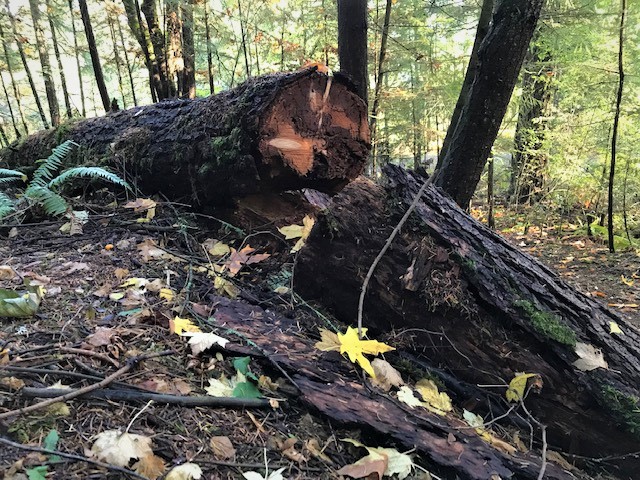Firewise on the Island Drive Trail
/Volunteers gathered at the base of the Island Drive trail on October 27 to clear dead brush and thin the area along the trail. This was one of our regular Firewise projects in the Scenic Estates neighborhood.
The work day began with a presentation on how to maintain the “extended zone,” 30 to 100 feet from your home, as part of a defense space against wildfire.
“The inevitable forest fire”
The trail is a perfect setting to see how a dense, overgrown forest can be managed to resemble the natural system of regular, smaller wildfires.
“One of our biggest forest health problems is an over abundance of dead woody debris, which creates a risk for catastrophic fires. It is imperative that folks on Lummi reduce the fuel accumulation around their homes to prepare for the inevitable forest fire that will come,” according to Sean Tait, certified arborist and owner of Leaf on the Wind Arboriculture.
Sean tait pruning dead limbs
Previous to the Firewise volunteer day, Sean removed dangerous hanging and dead limbs so that our volunteers could safely remove it from the ground.
A better home for plants and animals
In the northwest, animals need a patchwork of landscapes to meet their needs. A thick unchanging dense forest is not historically natural. Wildfire would burn and clear the forest floor in places, offering varying habitats to feed, hunt, and raise young.
removing brush from the trail
Our neighborhood is classified as a wildland-urban interface. To minimize loss of homes and lives—and keep the forest healthy—we need to remove the dead fuel on the ground that would normally and regularly burn away.
This improves natural habitat. For example, native huckleberries thrive in thinned forest floor, but grow in decaying stumps or logs.
So we when we found large logs, we chopped anything suspended in the air so that the log was in contact with the ground. The wood will now absorb moisture from the soil, and provide home and nutrients to our wildlife neighbors. But now it’s not much of a fuel for fire.
A fallen tree is cut and left to rest on the ground
Hit a snag? That’s a good thing
snag trees make a great home
On the other hand, there is a large snag tree on the trail that was not removed. Dead snag trees, also called “wildlife trees” are another important residence. Trees actually provide more habitats for wildlife when they are dead. Birds and small mammals use snags for nests, nurseries, storage areas, foraging, roosting, and perching.
Reclaiming dangerous fuel
The best practice is to keep the energy and nutrients from fallen and over grown foliage, “fuel accumulation,” right where you found it.
You can create small, controlled burn piles in the area. This follows the understanding that charcoal from wildfires help process nitrogen, resulting in more productive soil. Make sure to follow outdoor burning regulations on Lummi Island.
Or use a chipper, and spread the chips around the area. This will speed up the decomposition of what is now wildfire fuel. The place not to use chips is in the “Immediate Zone,” up to five feet around a structure.
For this project, we had the opportunity to transfer all this future goodness to the neighboring Aiston Preserve, owned by the Lummi Island Heritage Trust. The preserve is in the process of reclaiming an abandoned quarry and needs native green waste. Thanks to our neighbor Mark Sexton for his large dumping trailer, we were able to deliver about 60 cubic yards of brush!
DUmping a load of brush at aiston preserve
That’s also an impressive measure of how much of wildfire fuel came from this short trail, just about 350 feet long! It goes to show, we all have a lot of work to do as we Firewise our way to a more safe and healthy neighborhood.
Isaac Colgan is the Lummi Island Scenic Estates Neighborhood Leader for Firewise USA. LISE has been a recognized Firewise Community since 2003, one of the first in Washington State. Contact Isaac at isaac@lisecc.com.










